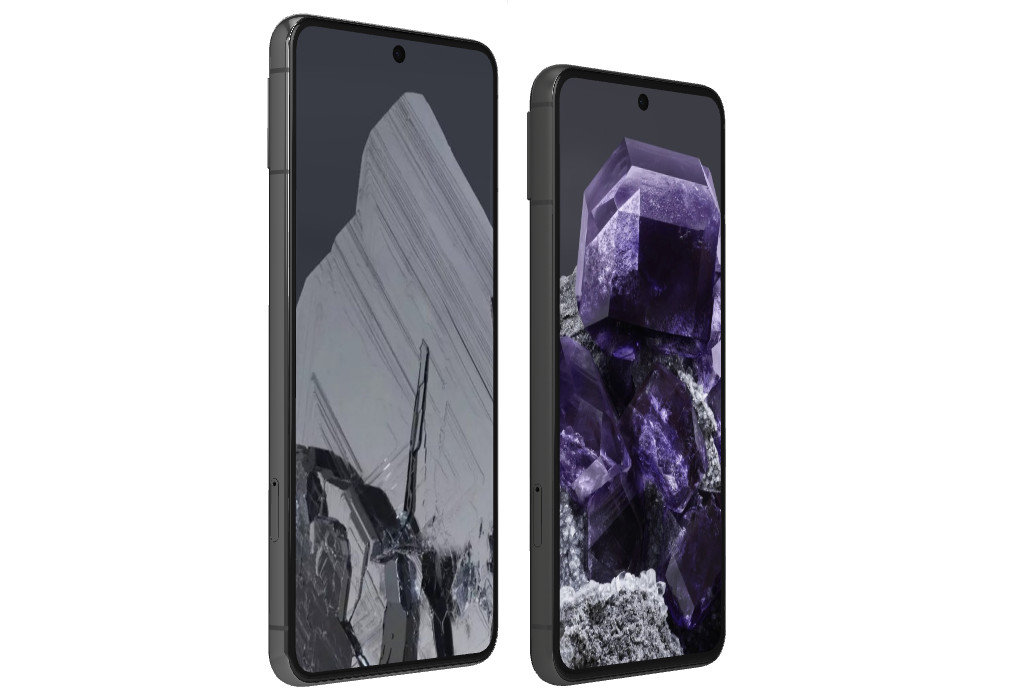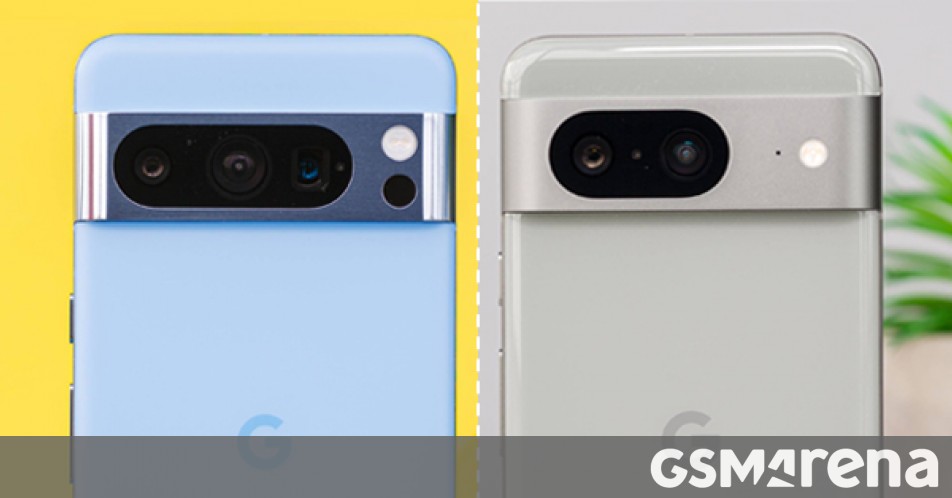The Google Pixel 8 duo this year brings a handful of improvements compared to its predecessors despite recycling the same design for a few generations now. The new generation offers new camera hardware, nicer displays, faster charging, and a more powerful chipset with improved AI capabilities. They are the first Pixel phones to offer seven years of full software support. In theory, they should receive Android 21.
However, if you are still determining which of the two you should get, we are here to help. Aside from the obvious differences in size and pricing, there are a few nuanced distinctions between the two, requiring a deeper dive. The feature disparity is bigger than you might think.
Table of Contents:
- Design
- Display
- Battery Life
- Charging Speed
- Speaker Test
- Performance
- Cameras
- Verdict
Let’s begin by comparing the complete specs sheets here.
Size comparison
Size and weight are the main differentiating factors when looking into the Pixel 8 duo. Those looking for a compact flagship phone will obviously go for the vanilla Pixel 8 – it is even smaller than its predecessors. Full-sized flagship enjoyers, on the other hand, are better off with the Pixel 8 Pro.
Size and weight-wise, the two flagships are competitive in their own categories without going overboard or standing out.
There’s no denying, however, that the Pixel 8 is considerably more comfortable in hand, fits every pocket, and is a delight to use with one hand. Meanwhile, the Pixel 8 Pro may prove unwieldy to some users.

Display comparison
Aside from the glaring difference in the display size, there’s a technological gap as well. While both devices boast better displays than their predecessors, the Pixel 8 Pro definitely wins in this department.
While both phones now offer 120Hz refresh rate, the 8 Pro runs an LTPO OLED panel capable of granular refresh rate control ranging between 1 and 120Hz, depending on the scenario. This helps save some battery life in the long run. The Pixel 8 Pro’s display can also be a tad brighter under direct sunlight, reaching 1,600 nits as opposed to the vanilla 8’s 1,446 nits. In real world, though, this won’t pose much of a difference. Additionally, the 8 Pro has a slightly higher screen resolution to match the bigger diagonal.
Their HDR capabilities are the same – HDR10+, but the protection level is slightly better on the 8 Pro. It offers Gorilla Glass Victus 2 sheet, while the 8 settles for the previous generation Victus.
Battery life
Surprisingly enough, the Pixel 8 and 8 Pro offer similar overall battery life, according to our Active Use score. Some small differences can be observed in the individual tests, though. The Pixel 8 is better in video playback, while the 8 Pro has higher call and web browsing runtimes, bumping up the Active Use score slightly higher than the vanilla’s.
That’s not what you’d expect from a bigger phone holding a larger battery, though. The Pixel 8 has a 4,575 mAh unit, compared to the 5,050 mAh cell inside the 8 Pro. Either way, the difference is marginal.
Charging speed
The charging capability of Pixels has always been the Achilles’ heel of the series, and while not ideal, this year’s upgrade in both handsets is a step in the right direction. The Pixel 8’s fast charging is rated at 27W, while the bigger one can go up to 30W. Wirelessly, the smaller Pixel settles for 18W charging, while the 8 Pro offers 23W. Both phones support reverse wireless charging.
When it comes to real-world testing, the vanilla Pixel 8 outpaces its bigger sibling by a small margin to all checkpoints – 15 minutes, 30 minutes and to a full charge. The difference is extremely small, though, and probably won’t make any difference in normal usage. The Pixel 8 is just 8 minutes faster to complete charging and leads throughout the whole test by just 2-3%.
Speakers test
In our speaker test, the two phones scored very similarly in terms of loudness – 26.6 LUFS vs. 26.0 LUFS in favor of the smaller Pixel. However, their audio tuning couldn’t be any different. The Pixel 8 Pro leans more to the bass-heavy side, at least by smartphone standards. This ensures fuller-sounding music and a warmer vibe to most tracks.
Whereas the Pixel 8 produces a flatter sound with clear vocals but lacks depth in a way. And while this is largely a subjective matter, we liked the larger Pixel better in this regard. Most tracks sound better on the Pixel 8 Pro.
Performance
Both the Pixel 8 and 8 Pro employ the brand new Google Tensor G3 chipset based on Samsung’s 4nm manufacturing process. The chip boasts improved AI capabilities and higher raw performance compared to its predecessors.
Still, since both devices share the same hardware, performance is pretty much identical, with a few caveats. For instance, in the onscreen benchmarks, the Pixel 8 outperforms the 8 Pro due to its lower resolution, so expect a lower frame rate in some games on the 8 Pro. The offscreen GPU tests show no statistical difference, as one would expect.
Google
Pixel 8 Pro
AnTuTu 10
1,151,243
Geekbench 6
1,766 single-core
Geekbench 6
4,492 multi-core
Google
Pixel 8
AnTuTu 10
1,158,631
Geekbench 6
1,668 single-core
Geekbench 6
4,404 multi-core
Another thing to keep in mind is memory. The Pixel 8 Pro offers a wider variety of storage configurations, going up to 1TB and 12GB memory across the board. The Pixel 8, on the other hand, has only two storage variants – 128 and 256GB and only 8GB of RAM, regardless of the configuration. And while this may seem enough by today’s standards, a couple of Android versions down the road, 8GB may not be sufficient. We just hope Google thought this through.
Camera comparison
This year, only the Pixel 8 Pro’s camera department gets the big promotion as the smaller Pixel settles for the same camera hardware as last year’s Pixel 8. In short, the overall camera experience will likely be the deciding factor for many buyers.
Sure, the main cameras of both phones are identical and offer identical quality; even the 2x crop zoom photos, which Google claims are nearly lossless, are the same. In both cases, you will be getting excellent photo and video quality during the day and night.
Pixel 8 Pro: 0.5x • 1x • 2x • 5x
Pixel 8: 0.5x • 1x • 2x
The 8 Pro’s auxiliary cameras are the ones you are paying extra, though. The bigger Pixel boasts a considerably better ultrawide camera thanks to its more potent 48MP sensor, and the dedicated 48MP telephoto camera delivers great 5x lossless stills. Something you can’t get from the smaller Pixel.
The low-light ultrawide samples also look nicer on the Pro, although the ones taken from the main cameras are identical.
Pixel 8 Pro: 0.5x • 1x • 2x • 5x
Pixel 8: 0.5x • 1x • 2x
But it doesn’t end there. For some reason, Google decided to omit some software-based features from the smaller Pixel, likely to drive up the interest for the bigger Pixel. Either way, with the smaller flagship, you will lose the Pro controls (meaning no manual control over stills and videos), access to the main camera’s full 50MP resolution and Night Sight video recording.
Here’s a glimpse of how the Pixel 8 Pro’s main camera compares in image quality to the Pixel 8’s in our Photo compare tool.
And here’s how the Pixel 8 Pro’s main camera compares in video quality to the Pixel 8’s in our Video compare tool.
Verdict
As you can see, the specs sheet isn’t the be-all and end-all when picking the right phone for you. Especially if you are deciding between phones belonging to the same family, like the Pixel 8 and 8 Pro. And in case you are still here wondering, then perhaps dimensions, weight and display size are not the deciding factors, because you would have picked the Pixel 8 if portability is what you are looking for. Conversely, the Pixel 8 Pro, if the big-screen experience is your thing.
But things are more nuanced. For instance, the Pixel 8 Pro has better-sounding speakers, while the Pixel 8’s charging speed and battery life are comparable to those of its bigger sibling. Performance is also identical, albeit the vanilla 8’s limited memory choice.
When it comes to camera, the Pixel 8 Pro is the clear winner here. Sure, the main camera and 2x zoom performance are identical, but you get a more capable ultrawide camera and a proper 5x telephoto camera with the Pro.
With all that said, we also have to put our findings into perspective. The MSRP of the small Pixel is €800/$700, while the price tag for the Pixel 8 Pro is €1,100/$1,000. That’s 300 bucks difference, which will likely sway you in one direction or another.
Do the €300/$300 difference justify the Pixel 8 Pro’s extra hardware and software features? We let you decide that one yourself, but if you are strictly looking for that Pixel experience, one could argue that the vanilla Pixel 8 gets you there for less.
- The bigger and more advanced display.
- The 5x telephoto camera, better ultrawide and more camera features.
- The better speakers.
- The extra RAM for future-proofing.
Get the Pixel 8 Pro for:
- The more compact and lightweight body.
- The considerably lower price.
- The slightly longer screen-on battery endurance.
Get the Pixel 8 for:
…. to be continued
Read the Original Article
Copyright for syndicated content belongs to the linked Source : GSMArena.com – https://www.gsmarena.com/google_pixel_8_pro_vs_pixel_8_review_battery_camera_price_compared-news-60648.php
